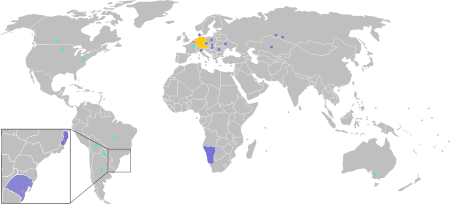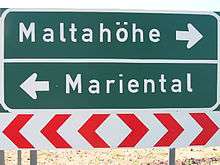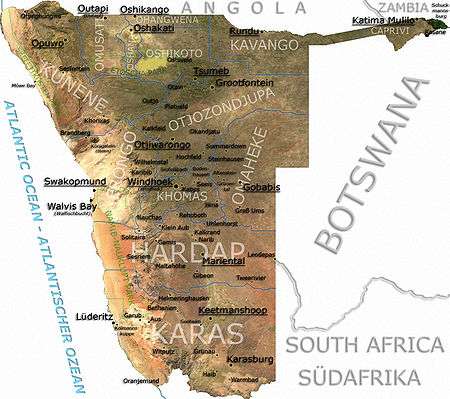German language in Namibia
Namibia is a multilingual country wherein German is recognised as a national language (a form of minority language). While English has been the sole official language of the country since 1990, in many areas of the country, German enjoys official status at a community level.[1]


German, a Germanic language, is especially widely used in central and southern Namibia and was until 1990 one of three official languages in what was then South West Africa, alongside Afrikaans and English, two other Germanic languages in Namibia. German is the main or mother tongue of about 30,000 Namibians, a number composed roughly equally of German Namibians as well as older black speakers of Namibian Black German and Namibians who as children grew up in the German Democratic Republic (East Germany). The German Namibian newspaper Allgemeine Zeitung on its website refers to 22,000 native speakers and of several hundred thousand who know German as a second or third language. German benefits from its similarity to Afrikaans and has a prominent position in the tourism and business sectors. Many Namibian natural features, place and street names have German names. However, Germanic linguist Ulrich Ammon sees the future of German in Namibia as threatened.[2]
History

During the period as a German colony from 1884 to 1915 German was the only official language in German Southwest Africa, as Namibia was then known. Boers, i.e. South African whites who spoke Dutch (South African Dutch would later develop into Afrikaans) already lived in the country alongside Orlam tribes and mixed-race Reheboth Basters.
South Africa took over administration of the country in 1915. However, German language privileges and education remained in place. In 1916 the Allgemeine Zeitung newspaper was founded under its original name of Der Kriegsbote. After the end of the First World War the South African attitude to the German Namibians changed, and between 1919 and 1920 about half of the Germans were transferred out of the country. In 1920 Dutch (later to be superseded by Afrikaans) and English replaced German as the official languages of the country.
The German-speaking population wished German to be reinstated as an official language and in 1932 the Treaty of Cape Town encouraged South Africa to do so.[3] It was hoped that this would throw a spanner in the works against South Africa annexing South West Africa into the Union of South Africa. South Africa did not officially recognise German; however, de facto German was added to Afrikaans and English as a working language of the government. Only in 1984 would German officially be added as an official language.
After independence in 1990, English became the sole official language of Namibia, and German thus lost its official status, but German today continues to be used in a wide range of spheres of Namibian life.
Situation today
Degree of use
About 31,000 Namibians speak German as a mother tongue, and several tens of thousands of Namibians, either white native speakers of English or Afrikaans or metropolitan black Namibians, speak German as a second language. German is taught in many schools, and is the medium for a daily newspaper, the Allgemeine Zeitung, as well as daily programming on the Namibian Broadcasting Corporation. Although German (and for that matter English) is not common as a mother tongue among the black population, a number of public servants especially in the tourism sector speak German to various degrees.
However, there are many spheres in which the German language is not or barely present at all — spheres with a small number of white people, especially in the north part of the country, but also in many neighbourhoods of Windhoek.
Culture
German is used as a medium of communication in a wide range of cultural spheres:
- Churches, most notably the German-speaking Evangelical Lutheran Church in Namibia (GELK)
- Schools (e.g. in the Deutsche Höhere Privatschule Windhoek)
- Literature (German-Namibian authors include Giselher W. Hoffmann)
- Radio and television (German-language programming of the Namibian Broadcasting Corporation)
- Music (e.g. artist EES)
- Online media (as standard German or Namdeutsch [Namibian German] in social media, forums or online newspapers)[4]
Education
In addition to 32 schools in which about 14,000 pupils learn German as a foreign language, there are about a dozen German-medium schools, including the Deutsche Höhere Privatschule Windhoek (DHPS), German schools in Omaruru and Otjiwarongo as well as five government schools. There are several additional elementary schools, German-medium high schools and a German-medium Gymnasium in Windhoek. The University of Namibia offers German-medium programs in German studies and business administration.
Signs

Signs for shops, restaurants and services are often in English and German, reflecting not only a high proportion of German-Namibian ownership but also the high number of German-speaking tourists that visit the country. However, a customer entering such as shop may well be greeted in Afrikaans; relatively fewer signs are in Afrikaans but the language retains a leading position as a spoken lingua franca in Windhoek and throughout the central and southern parts of the country.
German is also found on signs for tourists, especially those to monuments and historic buildings from the German colonial period. Other signs that include German date back before 1990, when English, Afrikaans and German shared status as official languages of the country.
Street names
In Windhoek, Swakopmund, Keetmanshoop, Grootfontein and Lüderitz many or most street names are German in origin, even though after 1990 many streets were renamed to honor black Namibian people, predominantly but not exclusively from the currently ruling SWAPO party. (See for example List of former Swakopmund street names). Streets named before 1990 often end in "Str.", the standard abbreviation in German for Straße, and in Afrikaans for straat; streets renamed since 1990 often end in "St.", implying the English abbreviation for "Street".[5][6]
Place names


Unlike other parts of the world with large German immigration and large numbers of German place names, only few places had their name changed, for example Luhonono, the former Schuckmannsburg.[7] Especially in the south, in the regions of Hardap and ǁKaras, many place names are German or Afrikaans. Examples include Keetmanshoop (after German industrialist Johann Keetman and the Afrikaans word for "hope", and Lüderitz, named after the German merchant Adolf Lüderitz.[8]
 Carstensen Bakery in Otjiwarongo
Carstensen Bakery in Otjiwarongo
Namibian German as a dialect
| Namibian German | |
|---|---|
| Südwesterdeutsch | |
| Namsläng | |
| Native to | Namibia |
Native speakers | 23,000 (2006)[9] |
Indo-European
| |
| Language codes | |
| ISO 639-3 | – |
| Glottolog | None |
The German language as spoken in Namibia is characterised by simplification and the adoption of many words from Afrikaans, English, and Ovambo and other Bantu languages. This variant of German is called variously Südwesterdeutsch (German südwest, southwest, referring to the country's former name, South West Africa); while younger people also call it Namsläng (i.e. Namibian slang) or Namlish.
References
- "Deutsch in Namibia" (PDF). Beilage der Allgemeinen Zeitung. 18 July 2007. Archived from the original (PDF) on 24 June 2008. Retrieved 23 June 2008.
- Stefan Fischer: Erhalt von Deutsch "fraglich". In: Allgemeine Zeitung. 13. September 2010.
- "Nach den Bestimmungen des Vertrages von Kapstadt wird die südafrikanische Regierung aufgefordert, deutsch als dritte Amtssprache einzuführen."
- Radke, Henning (2017). "'Lekker dieses namtal zu lesen. Ich hou davon.' Namdeutscher Sprachgebrauch in namibischer Onlinekommunikation". gm.winter-verlag.de. In: Germanistische Mitteilungen (in German). pp. 109–132. Retrieved 2018-02-18.
- Straße umgetauft. In: Allgemeine Zeitung. 19. Dezember 2001.
- Umbenennung sorgt für Irrwege. In: Allgemeine Zeitung. 19. Juni 2003.
- Nakale, Albertina (9 August 2013). "President divides Kavango into two". New Era. via allafrica.com. Archived from the original on 22 October 2014. Alt URL
- von Schmettau, Konny (28 February 2013). "Lüderitzbucht: Gründer- und Diamantenstadt" [Lüderitzbucht: Town of Pioneers and Diamonds]. Allgemeine Zeitung (in German). Tourismus Namibia monthly supplement. p. 6.
- German (Namibia) at Ethnologue (18th ed., 2015)
Literature
- Marianne Zappen-Thomson: Deutsch als Fremdsprache in Namibia., Klaus-Hess-Verlag, Windhoek 2000, ISBN 3-933117-15-1.
- Joe Pütz: Das grosse Dickschenärie. Peters Antiques, Windhoek Namibia 2001, ISBN 99916-50-46-6.
- Erik Sell: Esisallesoreidt, Nam Släng - Deutsch, Deutsch - NAM Släng. EeS Records, Windhoek Namibia, 2009, ASIN B005AU8R82.
External links
- Deutsch in Namibia (DiN) Initiative
- Allgemeine Zeitung Windhoek
- Deutsch-Namibische Gesellschaft
- Deutsch Quellenverzeichnis bei http://www.edsnet.na/
- IFA: Deutsche Sprachpolitik: Takt oder Taktik?
- IFA: Deutsche Sprachpolitik: Korrekt bis zur Selbstaufgabe
- Postkoloniale deutsche Literatur in Namibia (PDF file; 1.49 MB)